Tensegrity FlaxSeat: Exploring the Application of Unidirectional Natural Fiber Biocomposite Profiles in a Tensegrity Configuration as a Concept for Architectural Applications
Abstract
:1. Introduction
1.1. Biocomposites
1.2. Pultrusion and Pultruded Profiles
1.3. Tensegrity
1.4. Scope of the Research
2. Materials and Methods
2.1. Design Concept
2.2. Geometry Generation and Analysis
2.3. Tensegrity System Elements
2.3.1. Compression Elements
2.3.2. Tension Elements
2.3.3. Seating Area
2.3.4. Connections
2.4. Fabrication and Assembly Process
3. Results
3.1. Prototype of Basic Tensegrity Principle
3.2. Final Prototype: Tensegrity FlaxSeat
3.3. Architectural Application
4. Discussion
5. Conclusions
Author Contributions
Funding
Data Availability Statement
Acknowledgments
Conflicts of Interest
References
- Meng, B.; Liu, Y.; Gao, Y.; Li, M.; Wang, Z.; Xue, J.; Andrew, R.; Feng, K.; Qi, Y.; Sun, Y.; et al. Developing Countries’ Responsibilities for CO2 Emissions in Value Chains Are Larger and Growing Faster than Those of Developed Countries. One Earth 2023, 6, 167–181. [Google Scholar] [CrossRef]
- Bottega, L.; Brécard, D.; Delacote, P. Greening or Greenwashing? How Consumers’ Beliefs Influence Firms’ Advertising Strategies on Environmental Quality. 2023. Available online: https://ssrn.com/abstract=4522796 (accessed on 6 June 2024).
- Shubham; Ray, B.C. Fiber Reinforced Polymer (FRP) Composites in Ballistic Protection: Microstructural and Micromechanical Perspectives; Engineering Materials; Springer Nature: Singapore, 2024; ISBN 978-981-9997-45-9. [Google Scholar]
- Dahy, H. Natural Fibre-Reinforced Polymer Composites (NFRP) Fabricated from Lignocellulosic Fibres for Future Sustainable Architectural Applications, Case Studies: Segmented-Shell Construction, Acoustic Panels, and Furniture. Sensors 2019, 19, 738. [Google Scholar] [CrossRef] [PubMed]
- Dunne, R.; Desai, D.; Sadiku, R.; Jayaramudu, J. A Review of Natural Fibres, Their Sustainability and Automotive Applications. J. Reinf. Plast. Compos. 2016, 35, 1041–1050. [Google Scholar] [CrossRef]
- Madueke, C.I.; Mbah, O.M.; Umunakwe, R. A Review on the Limitations of Natural Fibres and Natural Fibre Composites with Emphasis on Tensile Strength Using Coir as a Case Study. Polym. Bull. 2023, 80, 3489–3506. [Google Scholar] [CrossRef] [PubMed]
- Dahy, H. Materials as Design Tool: Digital Fabrication Strategies for Sustainable Architecture. Technol.|Archit. + Des. 2023, 7, 153–158. [Google Scholar] [CrossRef]
- Spyridonos, E.; Witt, M.-U.; Dippon, K.; Milwich, M.; Gresser, G.T.; Dahy, H. Natural Fibre Pultruded Profiles: Illustration of Optimisation Processes to Develop High-Performance Biocomposites for Architectural and Structural Applications. Compos. Part C Open Access 2024, 14, 100492. [Google Scholar] [CrossRef]
- Spyridonos, E.; Gerstner, A.; Nehmeier, M.; Dahy, H. LeichtPRO-Profiles: Development and Validation of Novel Linear Biocomposite Structural Components Fabricated from Pultruded Natural Flax Fibres with Plant-Based Resin for Sustainable Architectural Applications. Mater. Res. Express 2024, 11, 075308. [Google Scholar] [CrossRef]
- BioMat Pavilion 2021: LightPRO Shell|Institute of Building Structures and Structural Design|University of Stuttgart. Available online: https://www.itke.uni-stuttgart.de/research/built-projects/biomat-pavilion-2021 (accessed on 6 June 2024).
- Fachagentur Nachwachsende Rohstoffe e. V. Pultruded Load-Bearing Lightweight Profiles Made of Natural Fibre Composites (LeichtPRO). Available online: https://biowerkstoffe.fnr.de/projekte/projektuebersicht/projekte-details?fkz=22027018 (accessed on 6 June 2024).
- BioMat at TIME SPACE EXISTENCE, Venice, 2023|Institute of Building Structures and Structural Design|University of Stuttgart. Available online: https://www.itke.uni-stuttgart.de/research/built-projects/biomat_time_space_existence (accessed on 6 June 2024).
- Spyridonos, E.; Reiner, A.; Dahy, H. Reciprocal Lightweight Structures with Natural Fiber Biocomposite Profiles through Computational Design and Case Studies Validation. In Proceedings of the IASS 2024 Symposium, Zurich, Switzerland, 26–30 August 2024. [Google Scholar]
- Gomez-Jauregui, V.; Carrillo-Rodriguez, A.; Manchado, C.; Lastra-Gonzalez, P. Tensegrity Applications to Architecture, Engineering and Robotics: A Review. Appl. Sci. 2023, 13, 8669. [Google Scholar] [CrossRef]
- Jacobsen, N. Tensegrity-Membran-Strukturen. Eine Studie über Entwicklung und konstruktive Umsetzung des Tensegrity-Prinzips im Bauwesen. Ph.D. Thesis, HafenCity Universität Hamburg, Hamburg, Germany, 2018. [Google Scholar]
- Rack, S. Formadaptive Tensegrity-Strukturen: Ein Beitrag zur Numerischen Simulation; KIT Scientific Publishing: Karlsruhe, Germany, 2019. [Google Scholar]
- Zhang, J.Y.; Ohsaki, M. Tensegrity Structures: Form, Stability, and Symmetry; Mathematics for Industry; Springer: Tokyo, Japan, 2015; Volume 6, ISBN 978-4-431-54812-6. [Google Scholar]
- Gan, B.S. Computational Modeling of Tensegrity Structures: Art, Nature, Mechanical and Biological Systems; Springer International Publishing: Cham, Switzerland, 2020; ISBN 978-3-030-17835-2. [Google Scholar]
- Charalambides, J.; Liapi, K. Square-Base Double-Layer Tensegrity Structures: Geometric Relations for Modular Tensegrity Assemblies. J. Archit. Eng. 2017, 23, 04017011. [Google Scholar] [CrossRef]
- Liapi, K.A.; Georgopoulos, T.; Ioannidi, A.; Kotsalis, A.; Nousias, C.; Spyridonos, E. Interactive Tensegrity Pavilion. Proc. IASS Annu. Symp. 2015, 2015, 1–12. [Google Scholar]
- Liapi, K.; Papantoniou, A.; Ioannidi, A. Double-Layer Tensegrity Networks of Helicoidal Shape: From Algorithmic to Physical Models. Proc. IASS Annu. Symp. 2018, 2018, 1–6. [Google Scholar]
- Liapi, K.A.; Papantoniou, A. Minimal Surface Tensegrity Structures: Design Algorithm Implementation in Real World Applications. In Italian Workshop on Shell and Spatial Structures; Gabriele, S., Manuello Bertetto, A., Marmo, F., Micheletti, A., Eds.; Springer Nature: Cham, Switzerland, 2024; pp. 626–635. [Google Scholar]
- Sarbadhikari, H.; Srivastava, S.M. A Course on Basic Model Theory; Springer: Singapore, 2017; ISBN 978-981-10-5097-8. [Google Scholar]
- Ida, T.; Kasem, A.; Ghourabi, F.; Takahashi, H. Morley’s Theorem Revisited: Origami Construction and Automated Proof. J. Symb. Comput. 2011, 46, 571–583. [Google Scholar] [CrossRef]
- Piker, D. Kangaroo: Form Finding with Computational Physics. Archit. Des. 2013, 83, 136–137. [Google Scholar] [CrossRef]
- Preisinger, C. Linking Structure and Parametric Geometry. Archit. Des. 2013, 83, 110–113. [Google Scholar] [CrossRef]



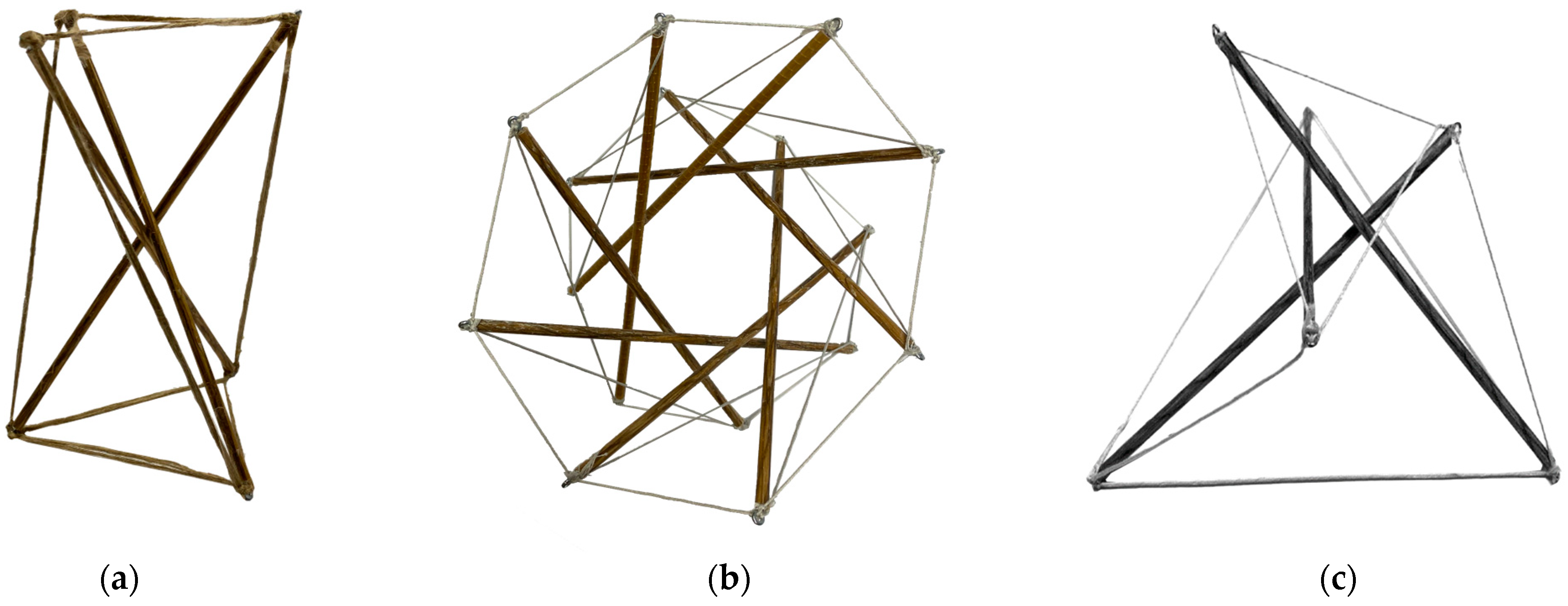
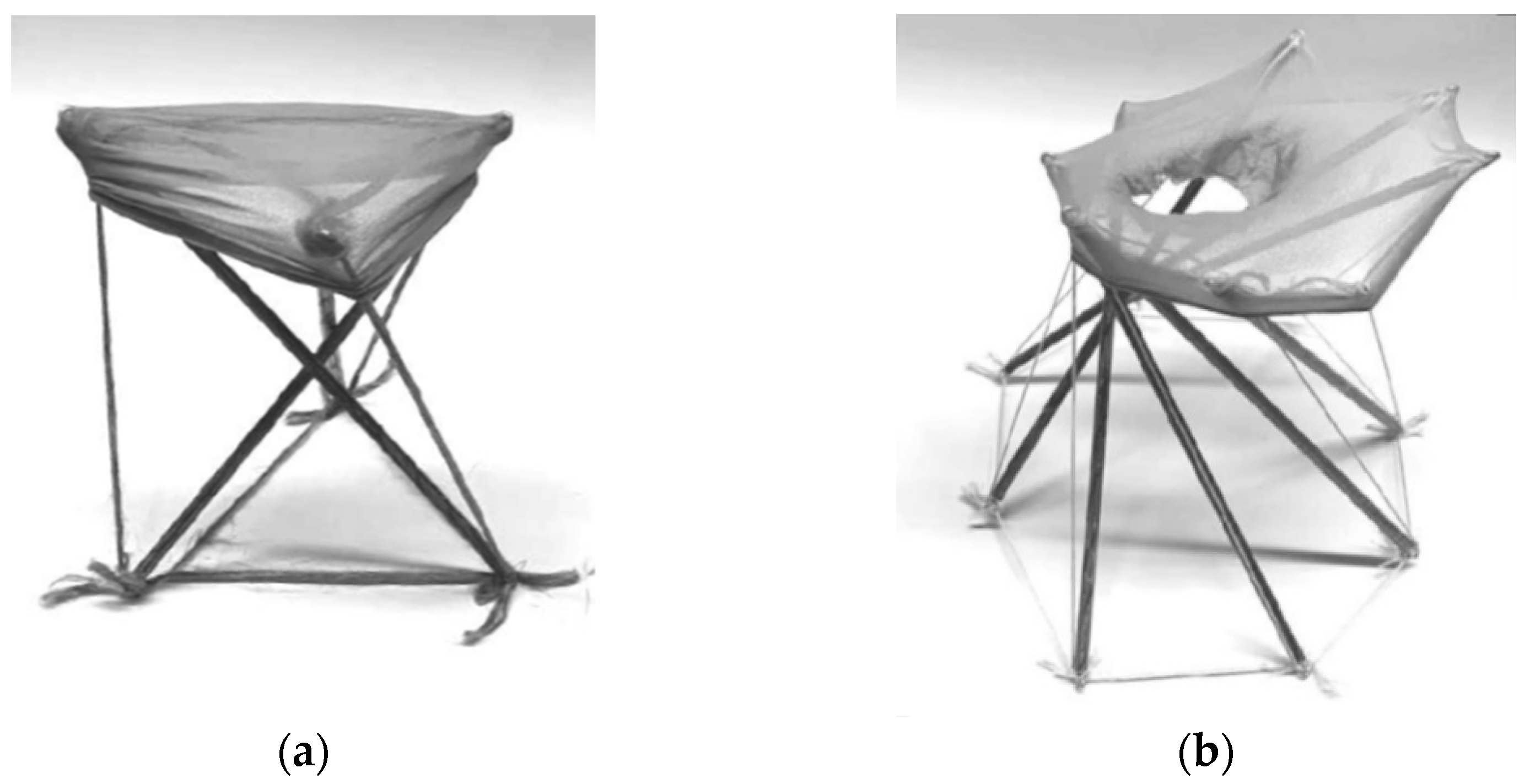

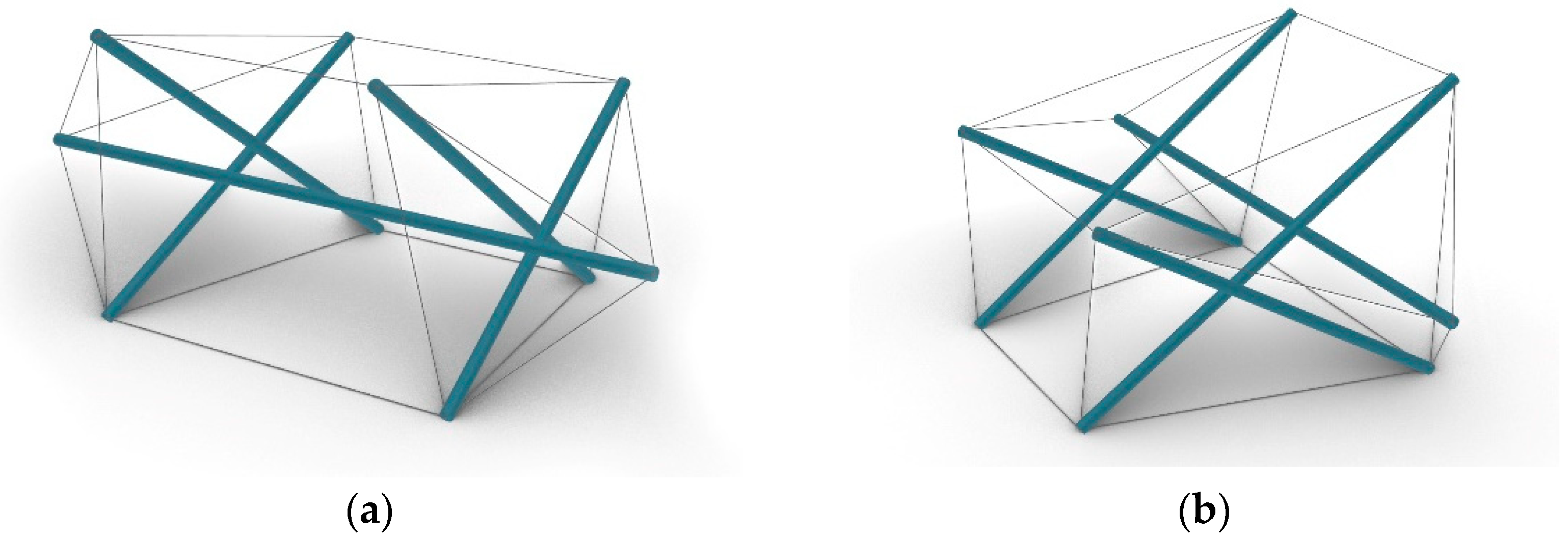
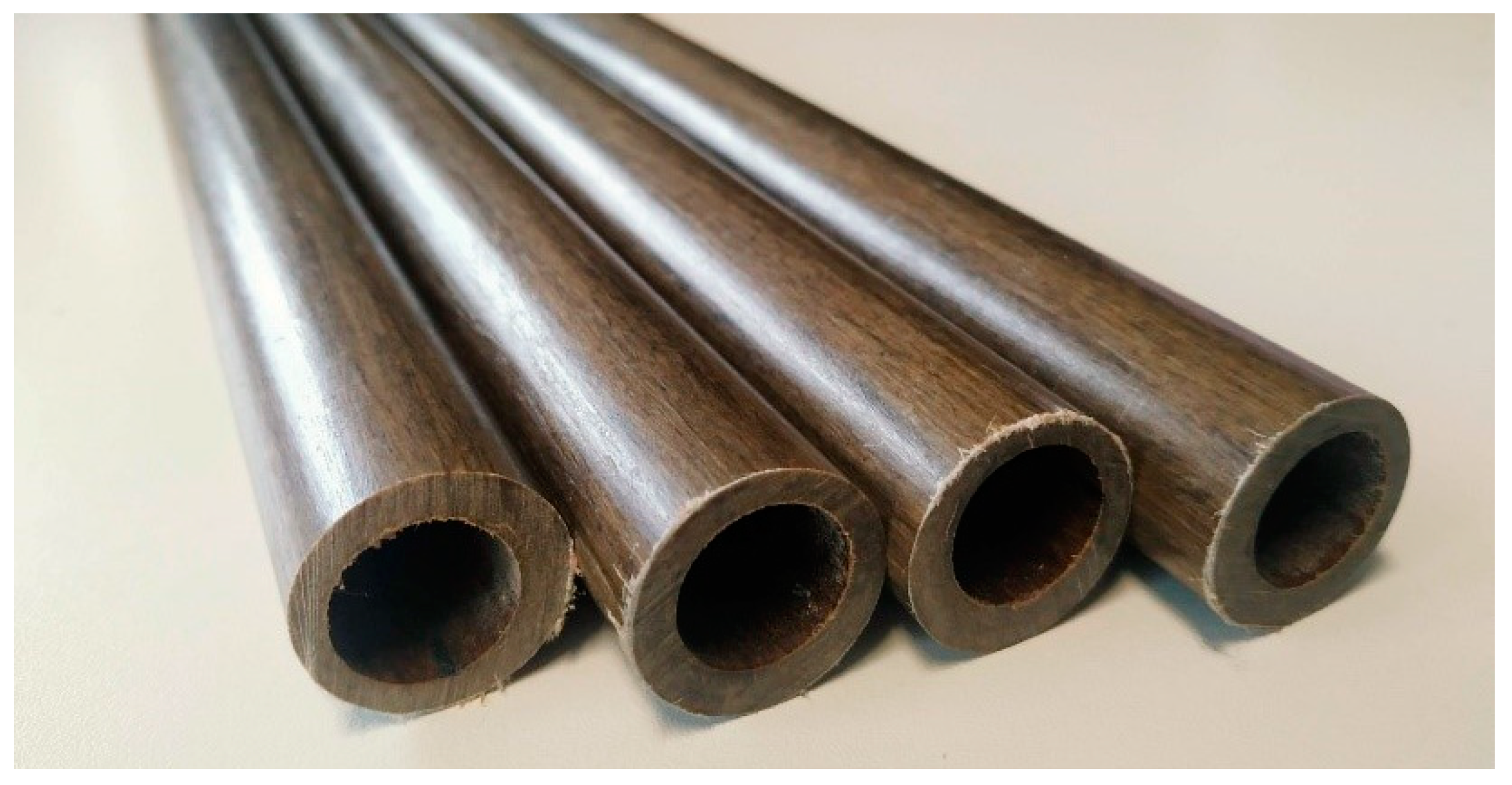
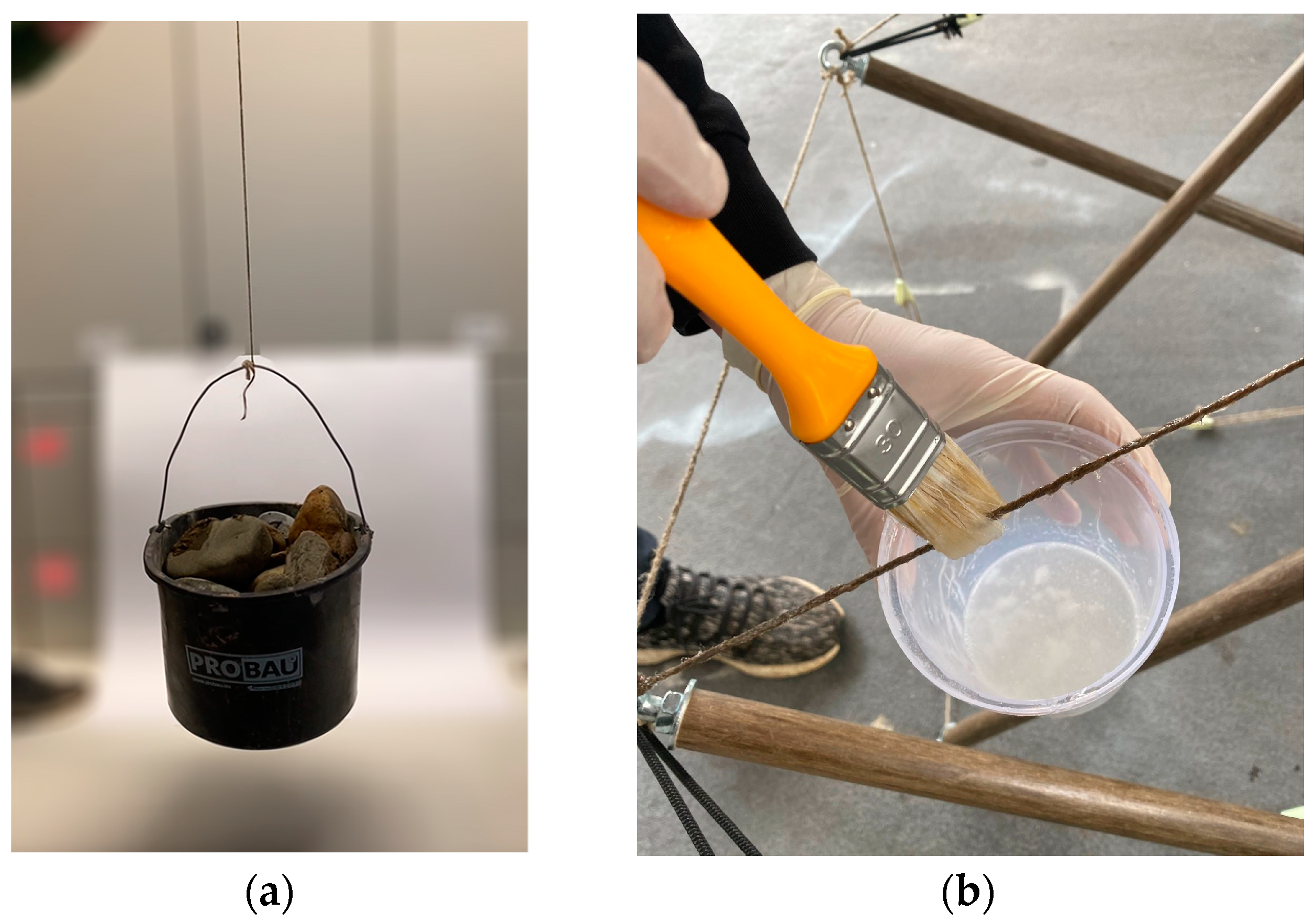

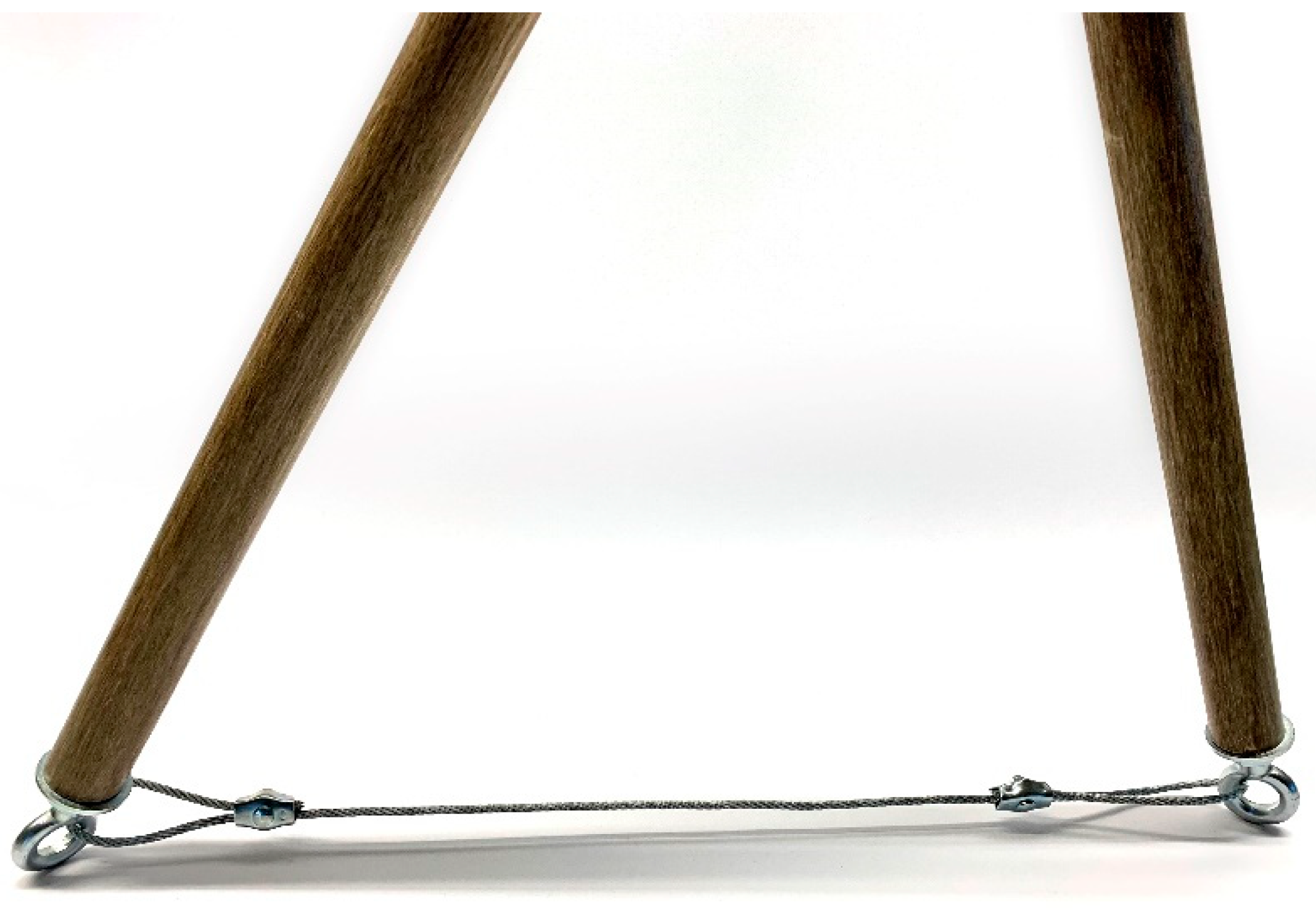
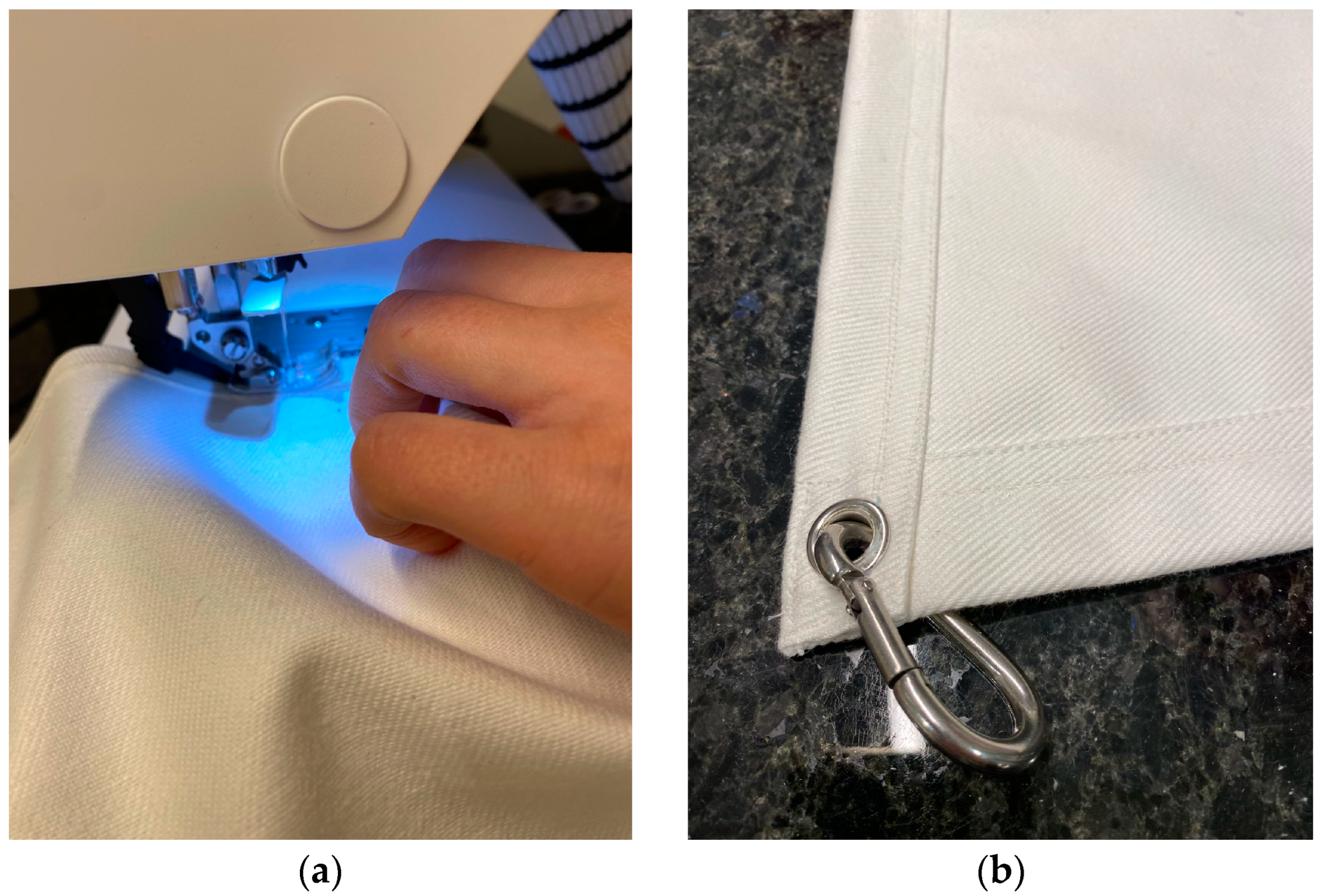

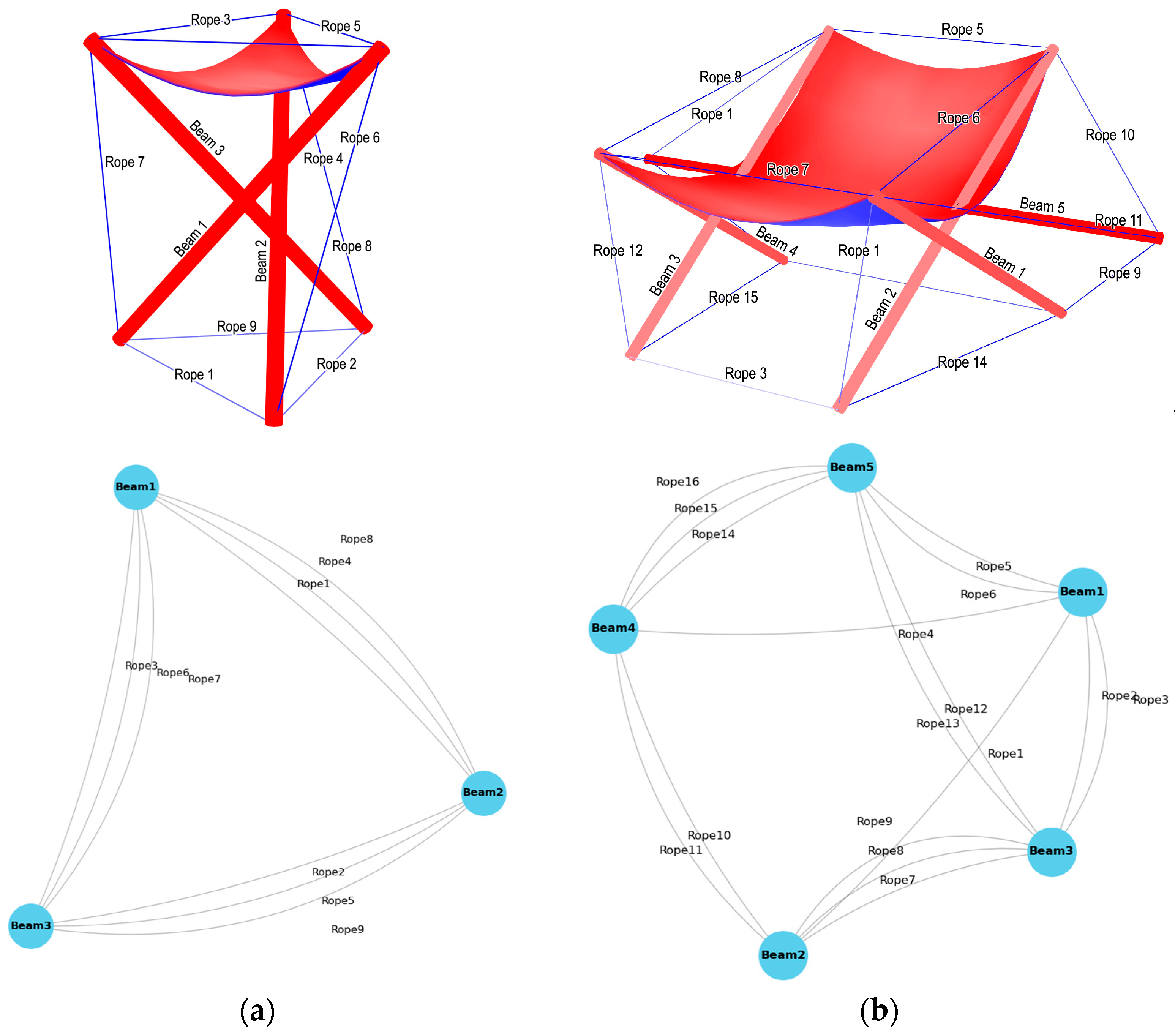
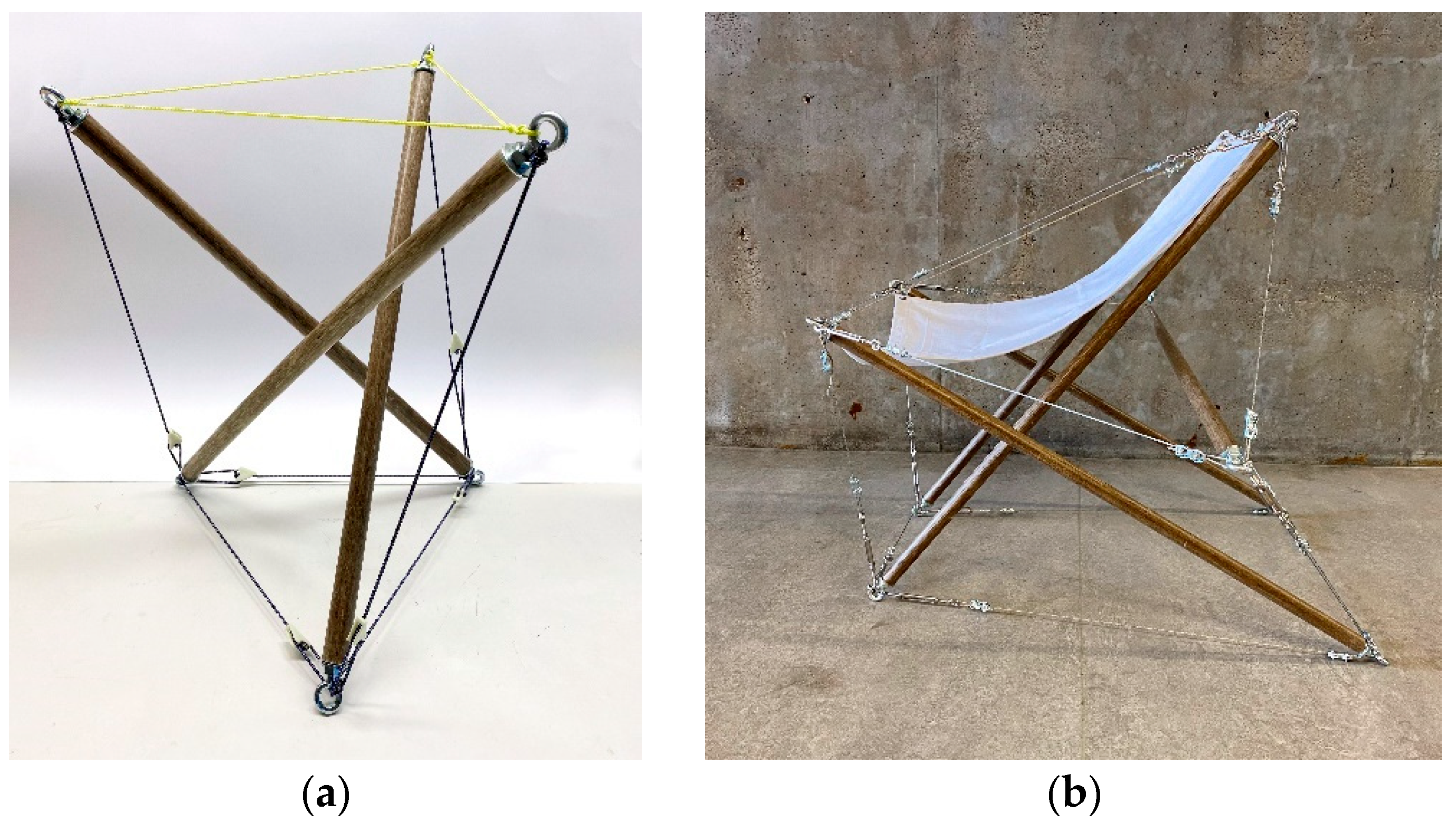
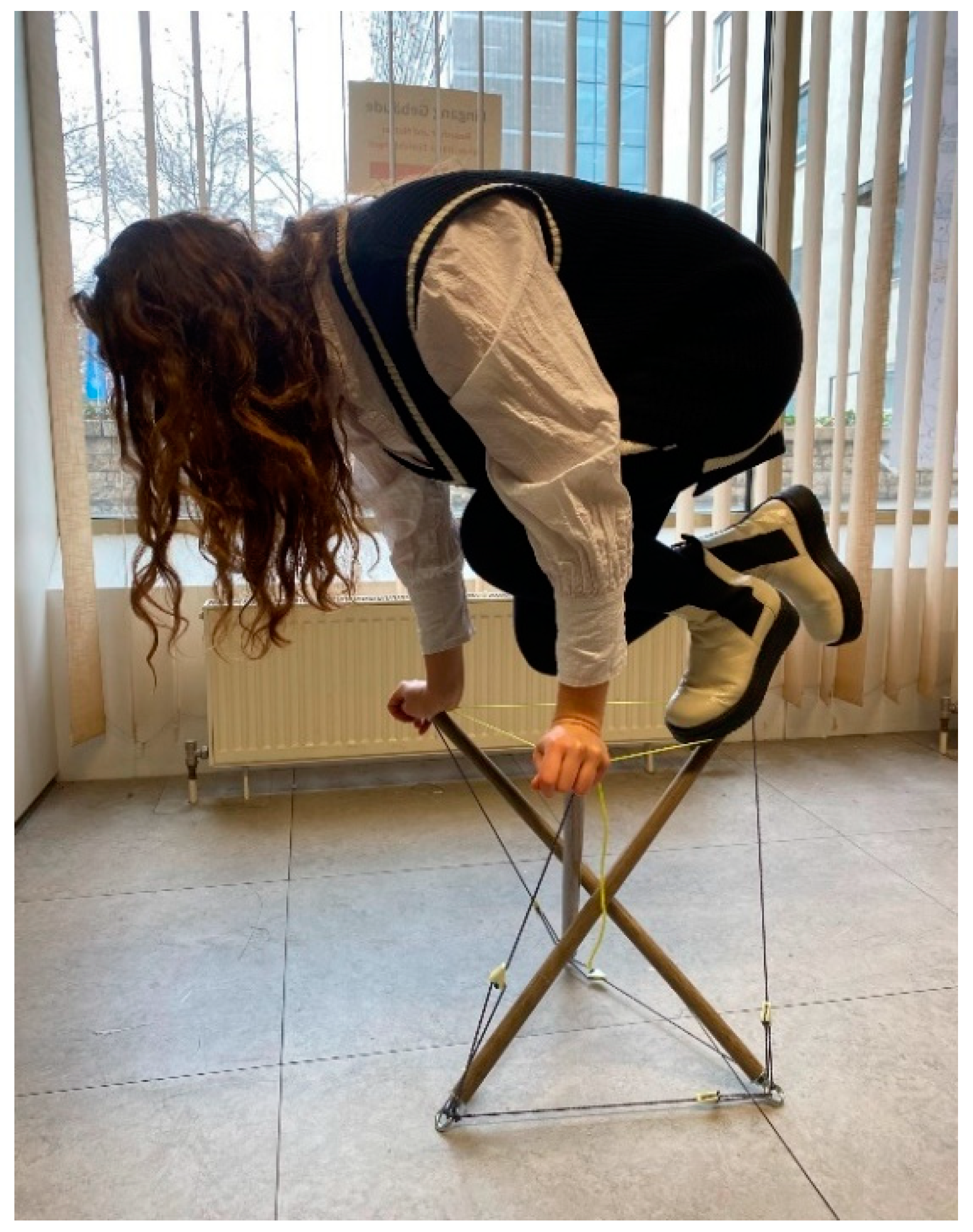

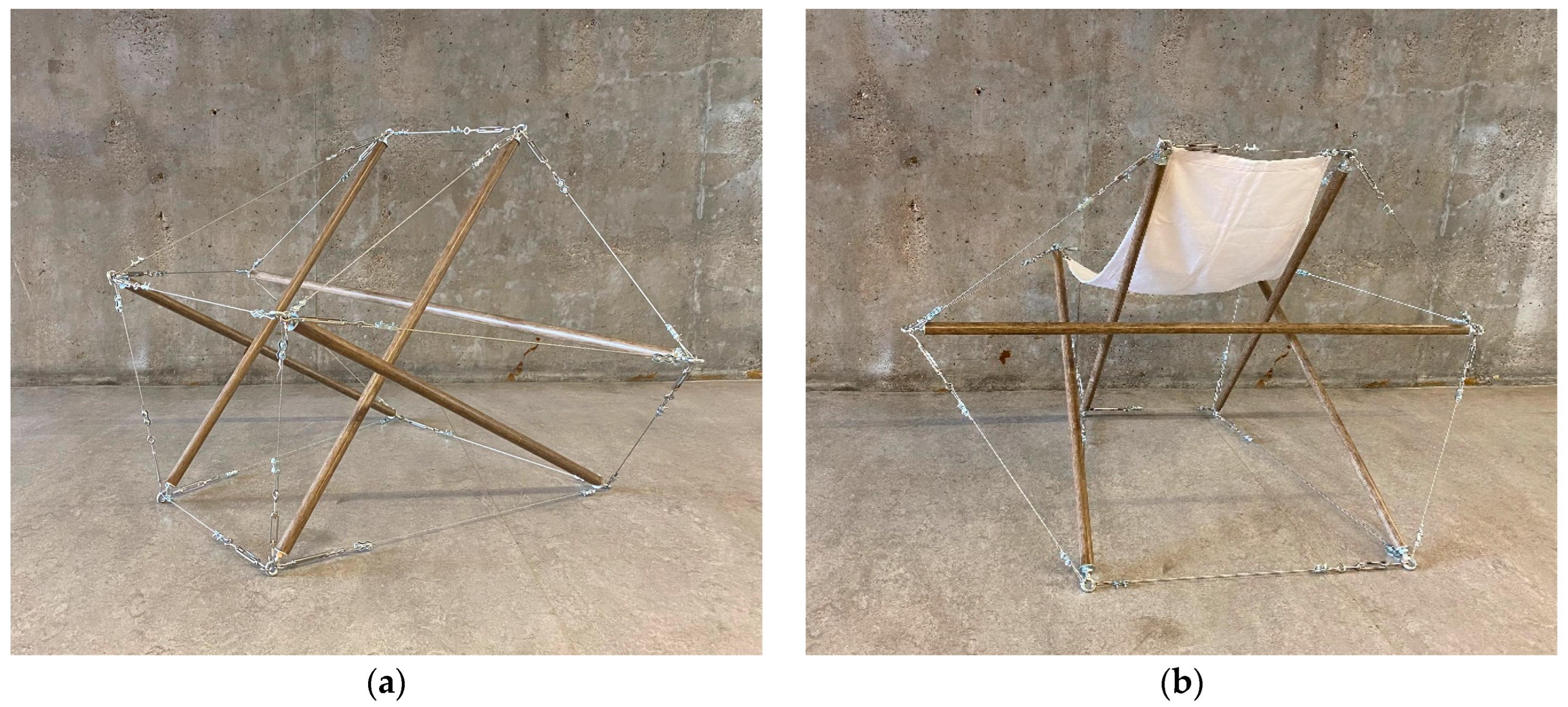
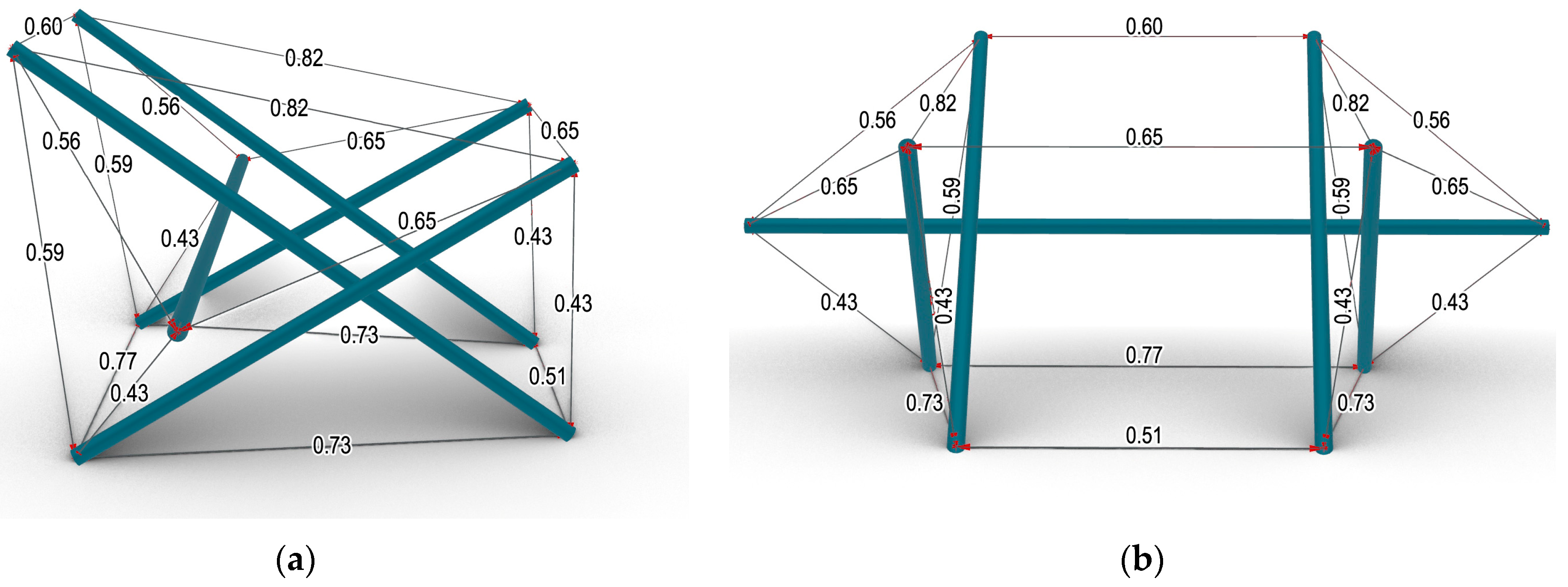
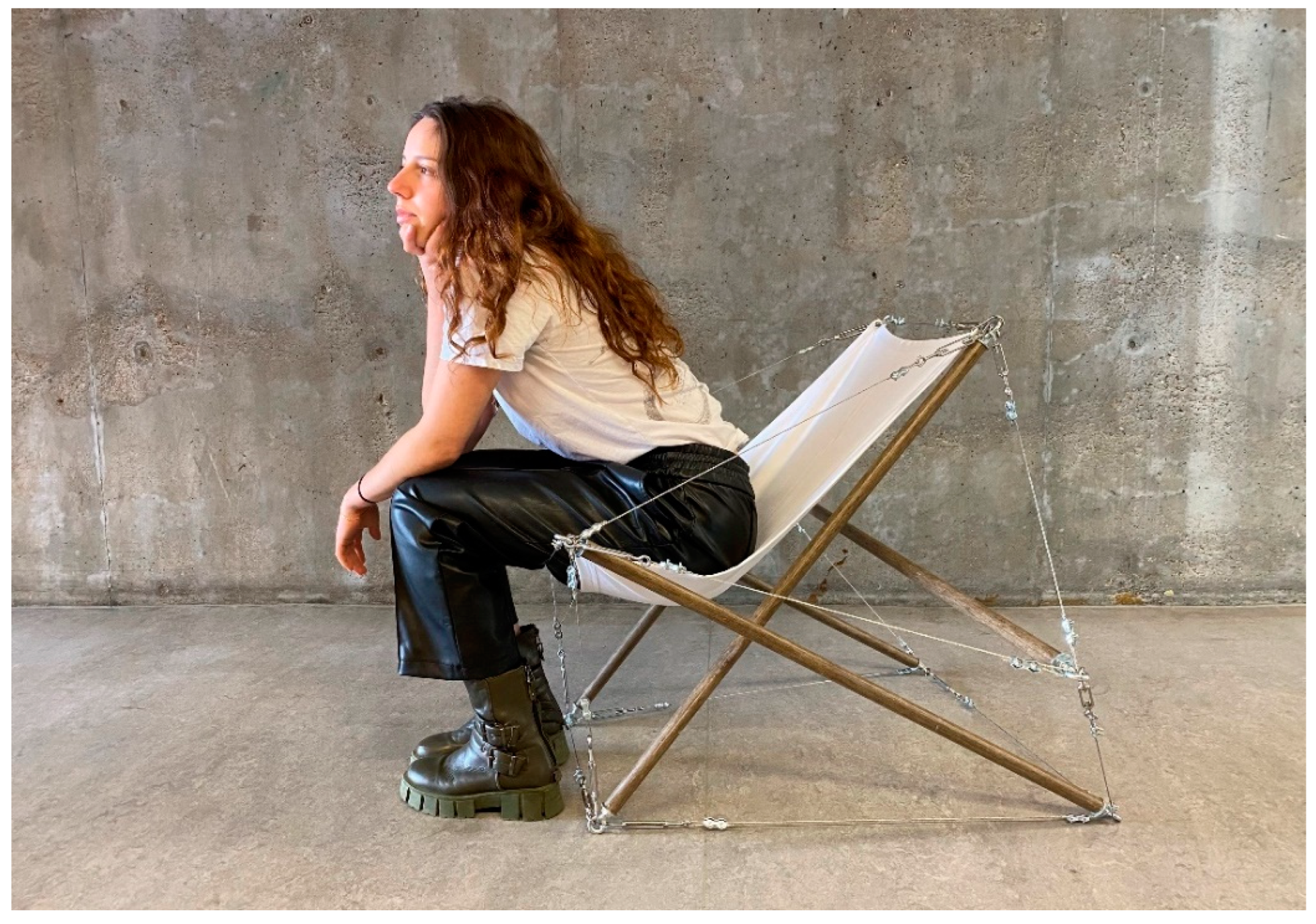
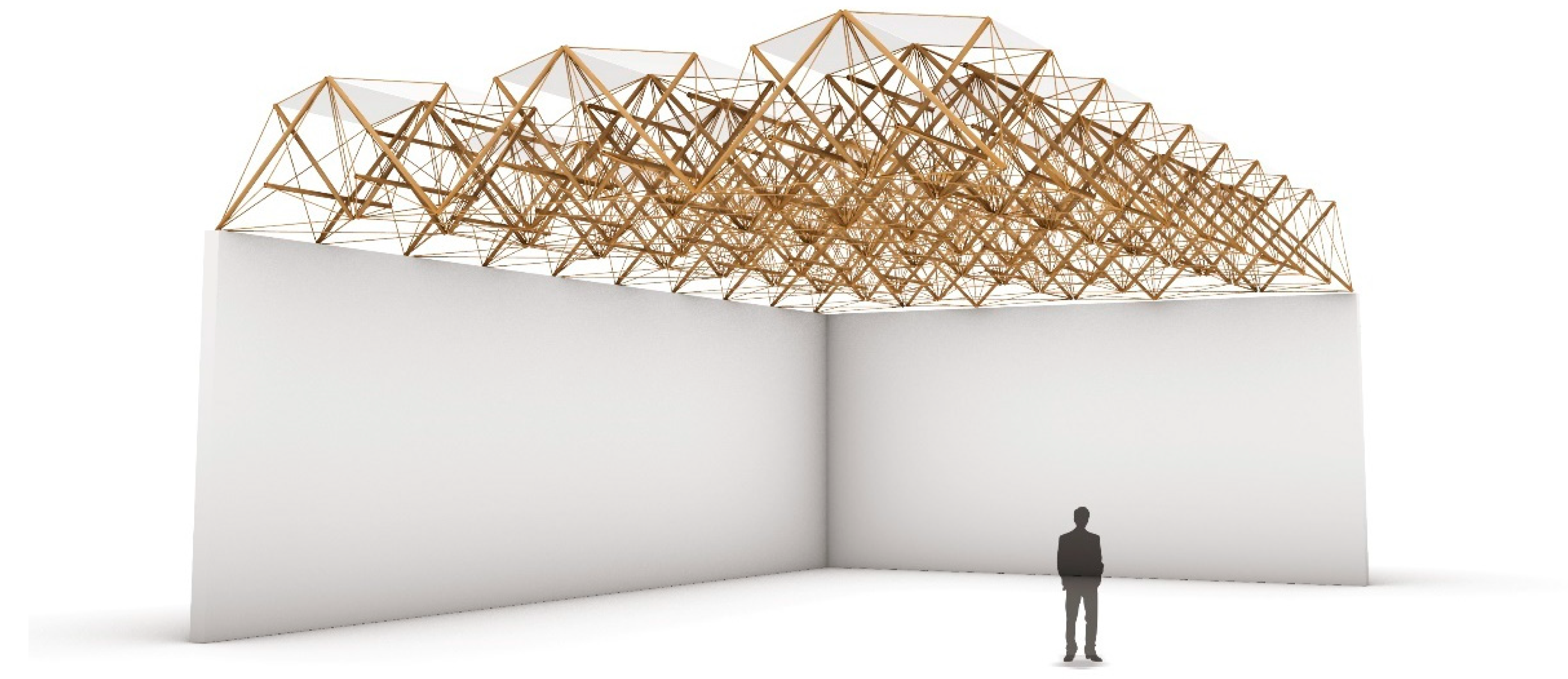
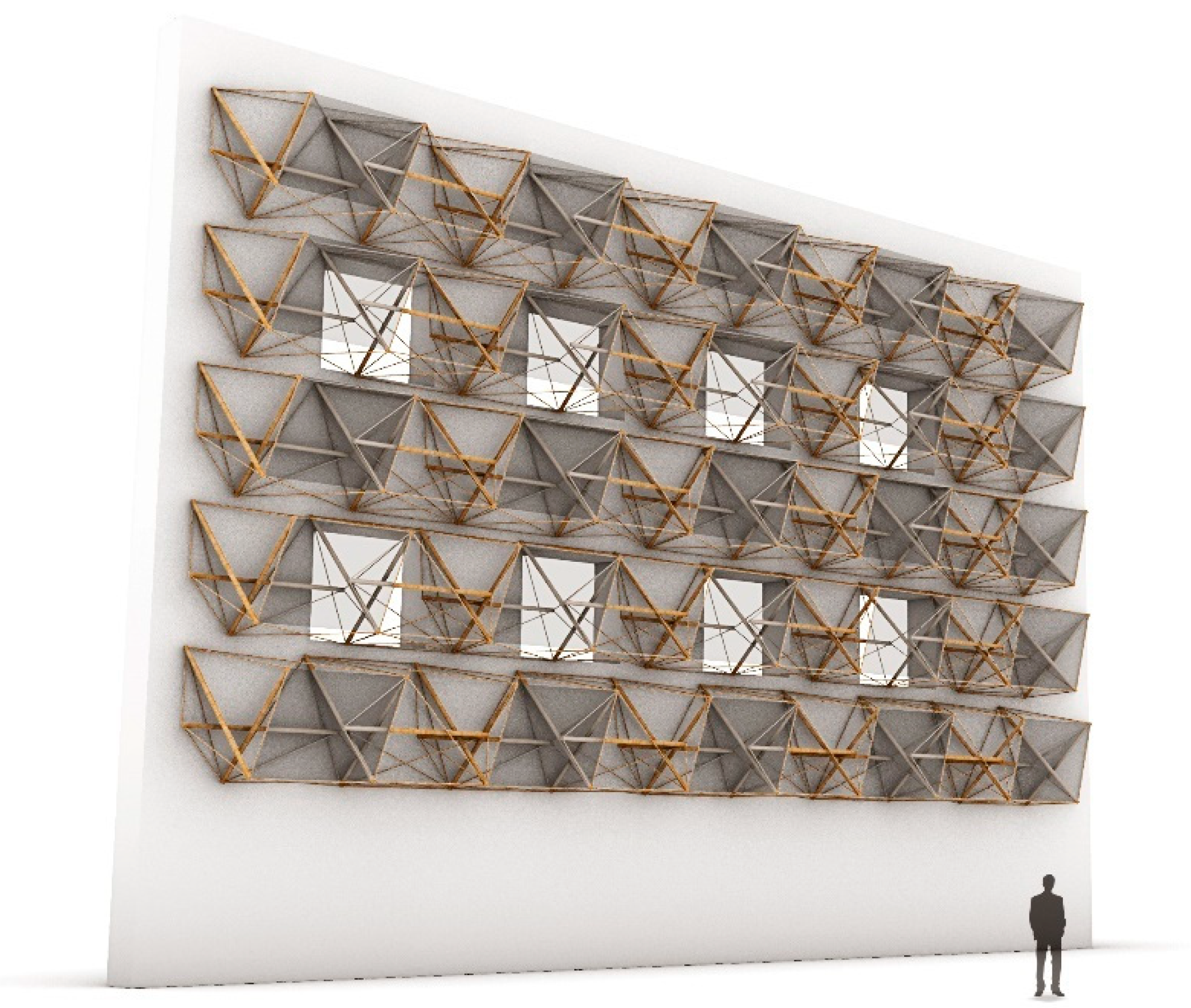
| Prototype 1 | Prototype 2 | |
|---|---|---|
| Number of profiles | 3 | 5 |
| Number of cables | 9 | 17 |
| Total length of profiles [m] | 2.10 | 5.00 |
| Total length of cables [m] | 4.10 | 11.00 |
| Textile seat area [m2] | 0.08 | 0.60 |
| Element | Reaction Force [kN] | Length [m] | Maximum Axial Normal Stress [kN/cm2] |
|---|---|---|---|
| Anchor 1 | 0.27 | ||
| Anchor 2 | 0.27 | ||
| Anchor 3 | 0.27 | ||
| Cable 1 | 0.42 | 21.82 | |
| Cable 2 | 0.42 | 21.83 | |
| Cable 3 | 0.42 | 21.82 | |
| Cable 4 | 0.42 | 39.3 | |
| Cable 5 | 0.42 | 39.34 | |
| Cable 6 | 0.42 | 39.35 | |
| Cable 7 | 0.54 | 40.54 | |
| Cable 8 | 0.54 | 40.53 | |
| Cable 9 | 0.54 | 40.57 | |
| Beam 1 | 0.7 | −0.41 | |
| Beam 2 | 0.7 | −0.41 | |
| Beam 3 | 0.7 | −0.41 |
| Element | Reaction Force [kN] | Length [m] | Maximum Axial Normal Stress [kN/cm2] |
|---|---|---|---|
| Anchor 1 | 0.18 | ||
| Anchor 2 | 0.18 | ||
| Anchor 3 | 0.24 | ||
| Anchor 4 | 0.24 | ||
| Cable 1 | 0.43 | 43.06 | |
| Cable 2 | 0.56 | 29.71 | |
| Cable 3 | 0.65 | 39.63 | |
| Cable 4 | 0.51 | 8.61 | |
| Cable 5 | 0.77 | 26.65 | |
| Cable 6 | 0.6 | 40.96 | |
| Cable 7 | 0.82 | 41.67 | |
| Cable 8 | 0.65 | 40.21 | |
| Cable 9 | 0.82 | 41.68 | |
| Cable 10 | 0.43 | 41.68 | |
| Cable 11 | 0.56 | 29.71 | |
| Cable 12 | 0.65 | 39.63 | |
| Cable 13 | 0.43 | 23.33 | |
| Cable 14 | 0.43 | 23.31 | |
| Cable 15 | 0.73 | 40.36 | |
| Cable 16 | 0.73 | 40.4 | |
| Beam 1 | 1.34 | −0.44 | |
| Beam 2 | 1 | −0.32 | |
| Beam 3 | 1 | −0.32 | |
| Beam 4 | 0.83 | −0.43 | |
| Beam 5 | 0.83 | −0.43 |
Disclaimer/Publisher’s Note: The statements, opinions and data contained in all publications are solely those of the individual author(s) and contributor(s) and not of MDPI and/or the editor(s). MDPI and/or the editor(s) disclaim responsibility for any injury to people or property resulting from any ideas, methods, instructions or products referred to in the content. |
© 2024 by the authors. Licensee MDPI, Basel, Switzerland. This article is an open access article distributed under the terms and conditions of the Creative Commons Attribution (CC BY) license (https://creativecommons.org/licenses/by/4.0/).
Share and Cite
Renner, M.; Spyridonos, E.; Dahy, H. Tensegrity FlaxSeat: Exploring the Application of Unidirectional Natural Fiber Biocomposite Profiles in a Tensegrity Configuration as a Concept for Architectural Applications. Buildings 2024, 14, 2490. https://doi.org/10.3390/buildings14082490
Renner M, Spyridonos E, Dahy H. Tensegrity FlaxSeat: Exploring the Application of Unidirectional Natural Fiber Biocomposite Profiles in a Tensegrity Configuration as a Concept for Architectural Applications. Buildings. 2024; 14(8):2490. https://doi.org/10.3390/buildings14082490
Chicago/Turabian StyleRenner, Markus, Evgenia Spyridonos, and Hanaa Dahy. 2024. "Tensegrity FlaxSeat: Exploring the Application of Unidirectional Natural Fiber Biocomposite Profiles in a Tensegrity Configuration as a Concept for Architectural Applications" Buildings 14, no. 8: 2490. https://doi.org/10.3390/buildings14082490






